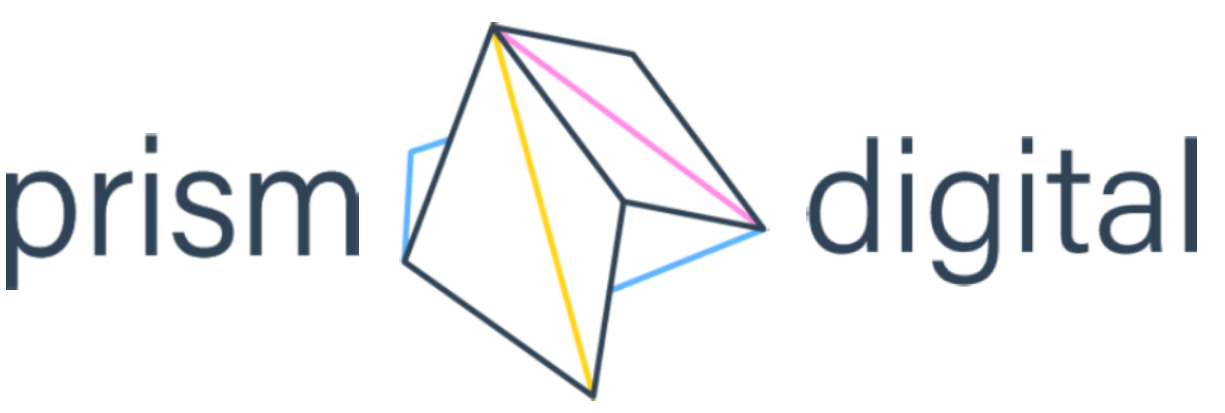Digital Marketing for
SaaS Companies:
The Ultimate Guide
Download PDF
Introduction
So you’re in the Software-as-a-Service (SaaS) industry and are looking for some advice on ramping up your marketing strategy. That’s great: You’ve come to the right place! We’ve put together this ultimate digital marketing guide using our in-house knowledge of the SaaS industry—and we’re about to show you how your business can build better marketing strategies to start seeing an increase in brand awareness, more software signups, and ultimately an abundance of sales.
What is SaaS Marketing?
As you’re likely already aware, software-as-a-service (SaaS) companies develop software that is stored online and sold to customers via the internet on a subscription basis. Because SaaS software differs from traditional products, SaaS companies also need to market in a different way. When it comes to software, it's important that any digital marketing efforts are aimed at building awareness around your unique SaaS organization. Building brand awareness is the key tactic when bringing a new software or service to the market, since your target audience is more likely to purchase from a brand they are familiar with and have positive associations with.
9 Digital Marketing Strategies SaaS Businesses Are Using to grow
Content Marketing
Even in a highly competitive field, your SaaS company can stand out from the crowd. By using content marketing, you will be able to develop and distribute helpful content to your audience in order to achieve the following:
Effective inbound marketing
Inbound marketing allows you to bring potential customers to your business rather than going out and finding them. Create educational content that is relevant to your potential customers’ needs and interests, and you’ll be able to form a meaningful and lasting relationship.
Remember: Content not only attracts leads, but it nurtures them too. Why not use one of the marketing tactics below to create some middle of the funnel content that moves users through the sales funnel?
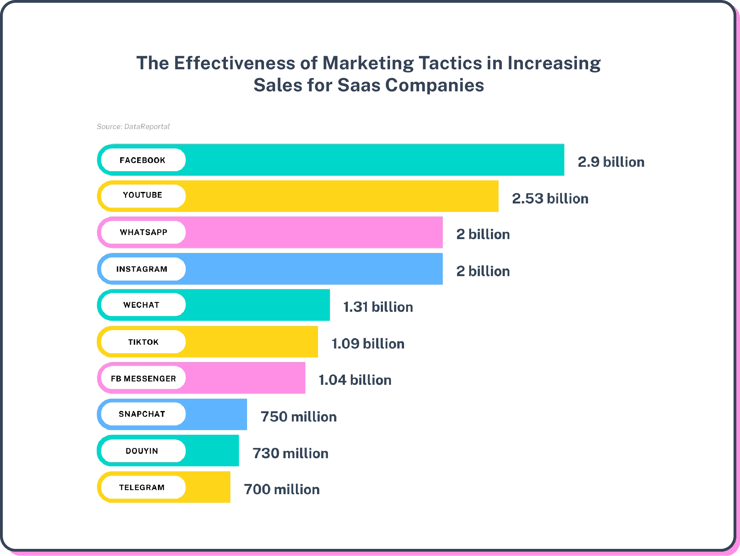
Brand awareness
Content marketing can be helpful when trying to raise awareness of your brand. When you create quality content, it shows potential customers what your software or services can do to fix their problems.
Trust and credibility
If you want people to buy from you, you’ll need to gain their trust through quality content. Creating trust in SaaS clients helps build a strong and lasting relationship, which leads to increased customer loyalty, improved customer satisfaction, and better sales.
Thought leadership
Thought leadership is a powerful tool, with two-thirds of marketers (66%) considering it to be a “top priority” for their marketing strategy. By creating high-quality content, you can introduce yourself and your brand to the world and build a reputation for being an expert in your field. Once this trust has been gained, your SaaS PR work is done primarily by your customers, whether this is by sharing content, building up a social media following or advocating for the business through word of mouth.
Increases in website traffic
If you want to see digital growth, you’ll need to get potential customers over to your website. This is where quality-content creation can help. First, it’ll get you a higher ranking in search engines, which will result in more people finding your website. Secondly, content marketing will increase engagement with your target audience, making them more likely to share what they’ve read with others, visit your website, sign up for your email list, and eventually become paying customers.
Social Media Marketing
Given that there are so many SaaS products on the market, it’s imperative that your social media strategy does the trick, emphasizing the value that your software provides in order to gain the desired traction. Let’s explore how this can be achieved.
Learn the social media platform
Today, there are dozens of social media sites (if not hundreds) that crop up every single day, however by spreading your resources thinly across diverse platforms, you’re more likely to incur financial losses. Instead, choose only the key social media platforms that your target audience uses. Once you have identified these, try joining existing conversations to find leads and achieve the main objective, which is to transition these users to email subscribers.
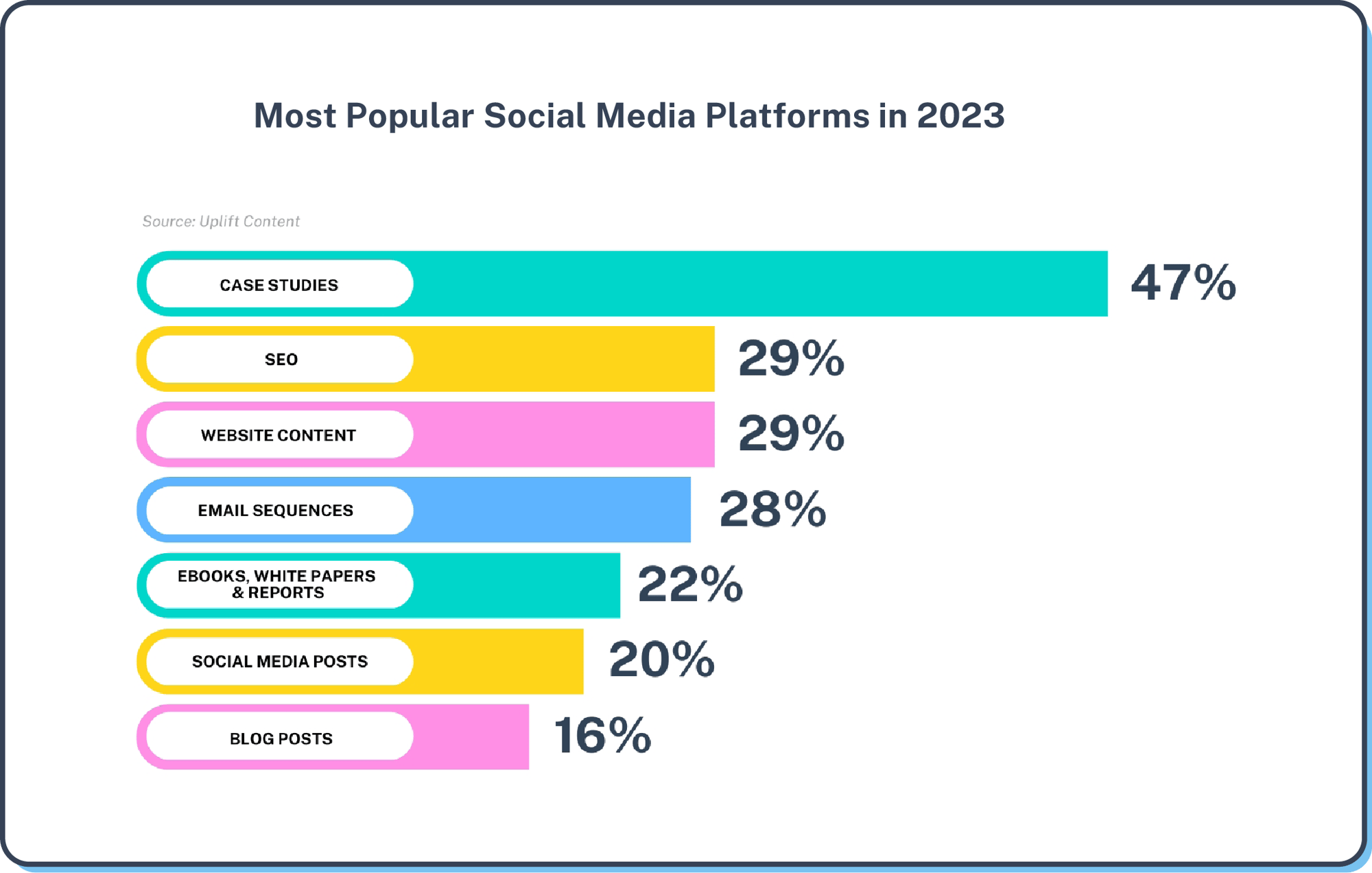
Know your target audiences
It’s important to know who you’re targeting, so make time to take part in meetups and online discussions connected to your software and the industry as a whole. You could even talk to competitors’ customers to learn what they perceive as the pros and cons of the respective software or services.
Invest in high-quality visuals
No matter which platform you use, visuals are important. Infographics need to be detailed, and the statistics need to be verified. Pictures should be high definition and gifs need to be visible on the platform—not a link that takes you to a third-party website.
Create partnerships
The very nature of social media is that it is collaborative, so it makes sense that creating partnerships with complementary businesses will only benefit your SaaS company.
Stop gating all of your content
Many SaaS companies “gate” their content in order to collect user’s contact information. It’s an effective lead generation strategy, however it can create another roadblock for users to pass through, ultimately hampering their interest and hurting your conversions. Why not try a bolder approach of providing some information outright? Transparency goes a long way in establishing credibility.
Utilize paid ads
When it comes to SaaS marketing, paid ads are hard to beat. By harvesting and sharing important demographic data, social media platforms allow you to enter communities that you wouldn’t be able to reach otherwise. The aim of the game is to develop an audience that you can communicate with consistently, then retarget them with offers for your software and services.
Retargeting
With retargeted display ads boosting the chances of a website conversion by 70%, your SaaS company should, if you’re not already, ride the retargeting wave! Designed to ‘keep tabs’ on whoever leaves your website without making a purchase, the tracking system enables you to nurture leads through the long sales cycle and beyond, retargeting them through the usual social media platforms.
Here are some common strategies:
Reach back out to website visitors
For SaaS companies—brand awareness is everything. So why not keep thighs simple and start by remarketing to everyone that visits your website (and already has a small taste of what your brand has to offer)? By re-engaging with previous website visitors, you’ll stay at the forefront of their mind. We’d recommend having the Facebook Pixel installed on your website so you can use their Business Manager to build your ad. This way you can create a custom audience and tell Facebook who you want to see your ad: Are you looking to retarget any potential customer who visits your site or only the people who have visited specific pages?
Connect with free trial users
Free trials are a crucial component to converting SaaS customers, however asking for credit card details upfront can reduce the number of free trial users who convert into paying customers. Using retargeting, you can nurture and support your prospects during their trial, gently encouraging and reminding them to convert.
Target your gated content downloaders
It’s frustrating when your e-books and white papers receive traffic that doesn’t convert. These middle of the funnel leads are engaging with your content, but they’re not quite ready to buy. The encouraging news is that the information your prospects have handed over can be used for retargeting. Ideally, you’ll do this by providing more value-added content, or an enticing offer (such as a free trial) to convert them into a paying customer. These strategies increase your brand awareness, and create trust in your company.
Nurture your current customers
The secret to success in the SaaS world? Customer retention! With the average churn rate for SaaS companies falling between 10 - 14% annually, it makes sense to look after your current customers. One of the most effective ways to do this is by using retargeting as a retention strategy. Be sure your current customers know about any valuable content you’ve uploaded, new software features that are relevant to them, and any SaaS awards your company has won.
SaaS-Specific SEO
68% of online experiences begin with a search engine, making search engines one of the biggest traffic sources to most websites. Without a solid SEO strategy in place, it’s easy for SaaS businesses to get lost in the crowd and miss out on potential customers. After all, only 0.63% of Google searchers will click on results any further than the first page.
In order to get yourself seen on page 1 of the search engine results pages (SERPs), and increase traffic to your website, you’ll need to rank for relevant keywords. Ultimately, this will put your business in front of the right audience and ensure not only organic traffic, but high-quality website visitors. When potential customers see your site at the top of SERPs, they will naturally view your company as being more credible and trustworthy than those further down the page. If you want to look like you’re an authority in your industry, you need SEO!
Let’s consider some best practices:
- Set measurable KPIs and goals—these metrics will reveal the effectiveness of your keyword targeting, content optimization, backlink building, and other SEO activities that are vital to your overall outreach and sales.
- Carry out keyword research to identify the right keywords to target—this will help you identify relevant words that your target audience is using to search for SaaS products or solutions, so you can better understand their intent.
- Optimize your website’s on-page SEO—this can help to increase the relevance of your content and make your website appear attractive to potential customers. Remember: Well-optimized images can rank on their own in Google's image search.
- Publish high-quality, keyword-rich, and topically connected content—such pieces will help you gain organic search visibility, rankings, and traffic.
- Promote your content through outreach and link building—links are a signal to Google that your site is a quality resource worthy of citation.Common link building strategies include content marketing, email outreach, broken link building and public relations.
Continuously monitor your SEO progress and adjust your strategy as needed—this will allow you to objectively identify what's working with a campaign and what needs improvement. Knowing the value of your SEO services to clients is vital for increasing client retention.
Software Trials
Due to SaaS customers typically paying for software monthly or annually, as opposed to buying a product outright, it’s important that your company focuses on maintaining a steady stream of new subscribers. One common approach for attracting new customers in SaaS marketing is offering a free trial period. During this time, potential customers can try out your software and see if it meets their needs before committing to a paid subscription. But what are the advantages and disadvantages of this strategy?
|
Advantages Free trials allow your company to: |
Disadvantages You may want to avoid: |
| Generate leads easily: Free trials provide a low-commitment way for potential customers to engage with your software, providing warm leads for your sales team. |
Free trial seekers: Naturally, you may experience some customers who have absolutely no intention of becoming paying subscribers. These freebie seekers will increase your customer acquisition costs and customer churn rates, moving on to the next company offering as soon as their trial period finishes. Unfortunately, such customers will decrease the overall ROI of your free trial strategy. |
|
Manage expectations: It’s better for both the customer and your company to find out if your software is a good fit. Offering a free trial will help avoid negative reviews, refund requests, and decrease churn rate. |
Increased overhead costs: Offering free trials is only free to the customers, and not your SaaS company! Setting up, managing and providing support all cost you time and money, especially if you have a high volume of trial sign-ups. |
|
Eliminate the fear of long-term commitment: Particularly if your software carries a hefty price tag, potential customers may hesitate to commit to a subscription without trailing it first. |
Becoming ANOTHER SaaS provider: In the SaaS industry, free trials have become the norm. In fact, customers expect them. Because of this, it’s difficult to stand from the sea of competitors all offering similar free trial options. The solution? Nail down your unique selling points and effectively communicate those to potential customers during the trial period. |
|
Gain valuable feedback: Free trials offer the perfect opportunity to gather feedback in the form of surveys during and after the trial. |
|
|
Gather essential data: By capturing information on how free trial customers use your software, their demographic information, and where they found out about the free trial, you can optimize your marketing efforts and target better leads. |
|
|
Grow your email list: So your software wasn’t a fit for a particular customer, that doesn’t mean they won’t be interested in future offerings! |
|
|
Increase sales conversions: It’s good practice to have a sales funnel already in place during the free trial period in order to guide users towards your paid subscription. We’d recommend including onboarding emails, personalized support, and special offers or discounts. |
Google Ads
A well-organized promotional strategy can be highly effective in helping your SaaS company to make a name for itself. Because Google has 92.48% of search engine market shares all over the world, there’s no doubt that Google Ads can provide a huge opportunity to reach maximum numbers of target customers. Let’s explore how:
- Google Ads offers one of the best ways to improve your ad performance. Having trouble getting a high enough click-through rate? Google Ads allows you to test different formats to find out which ad performs the best. You can play around with text, image, and background color combinations to find out what works best for your SaaS brand and audience.
- When you integrate Google Analytics with your CRM, you can pull up your closed sale data to see what's driving revenue. This provides a better return on investment than traditional online advertising.
- In order to build successful brand value, you need to create ads that generate interest and engage your target audience, so you can increase your chances of capturing important leads and customers. Google Ads remains one of the most popular, widely used pay-per-click advertising options worldwide.
We’re now going to look at three different SaaS Google Ads strategies, with real life examples.
Free trial promotion ads
Highlighting upfront that there’s a free, no-risk trial communicates a level of customer satisfaction right from the start. Don’t forget, you also want to emphasize the key benefits of your SaaS software, as exemplified below.

Users demo ads
Demos are the gold standard for a lot of SaaS companies, especially those targeting large and enterprise-sized businesses. Considered to be more effective than singular free trials, demos can get an entire team of decision makers on board and effectively highlight what makes your software better than the competition.
Having ads that use Google Ads extensions to add links (as seen in bold font) to different demos will increase the odds of potential customers following through.

Competitor comparison landing pages
Linking your Google Ad to a product comparison landing page enables you to leverage your competitors’ brand awareness against them—a smart and effective way to showcase the value of your software on its own merit.

Referral Marketing
Referrals in SaaS are huge. They can provide your company with a consistent source of traffic and help win over new customers with minimal effort on your part. But how do you make yourself referral ready?
Create a referral program
By asking customers to think about people who would benefit from your software or services, they’ll likely provide leads that are a good fit for your brand. Since people are being referred by someone they know, this creates a natural word-of-mouth marketing experience. Potential customers then form the opinion that your company is trustworthy, which ultimately increases both your customer retention rate and your revenue.
Ask at the right time
We can’t stress enough how important it is to customize your referral process. For example, you wouldn’t want to be asking for a referral if you’re still in the process of creating deliverables—or worse, you’ve missed the mark on something! Be sure to coordinate with your teams to know when to reach out and consider pairing referral requests with positive news, particularly if you have success metrics to share.
Show your appreciation
A referral is a gesture worthy of gratitude, therefore it’s important to take the time to call or email your clients so they know how much you value their time and feedback. Some companies even offer referral incentives—a sure fire way to encourage additional referrals.
Create multiple ways for customers to recommend you
If you really want your existing customers to advocate for your software or services, you need to provide different avenues for them to do so. Common examples include, case studies, testimonials and online reviews. Ultimately, the more options you provide, the more convenient you make it for customers to share their feedback.
Co-Marketing
Co-marketing refers to a strategy where brands or organizations partner together to expand their reach and market more efficiently. Typically, the companies working with each other have some similarities, such as being in the SaaS industry or having similar audiences. The good news is, approaching co-marketing doesn’t have to be overly complex. Follow these five steps to choosing the right partner to launch a co-marketing campaign.
- Step 1: Find companies with a shared audience. Ideally, you're looking for potential customers who have similar interests, problems and attitudes towards solving their problems.
- Step 2: Identify any potential conflicts of interest. Even though your message will be cohesive and seamless, ultimately you'll want to attract different leads.
- Step 3: Play fair! In order for both sides to be happy, each company must pull their own weight, have a similar amount of resources and time, and be yielding similar benefits—such as a comparable amount of leads.
- Step 4: Create a formal feedback process. Constant review, analysis and adjustment are an essential part of co-marketing, therefore it’s important to bring all the key stakeholders together to discuss the results of your campaigns.
- Step 5: Build relationships. Co-marketing provides the perfect opportunity to create long-lasting partnerships. Form genuine connections based on shared goals and you'll develop a relationship that will last well beyond your latest campaign.
Account-based marketing (ABM) is a focused growth strategy used by SaaS companies to ‘weed out’ less-valuable customers early on. Designed to ensure that marketing and sales are in complete alignment, the strategy will allow you to create personalized buying experiences for a mutually-identified set of high-value accounts. By doing this, you can get to work on personalizing the buyer’s journey and tailoring all communications, content, and campaigns to those specific accounts—treating them as if they’re individual markets.
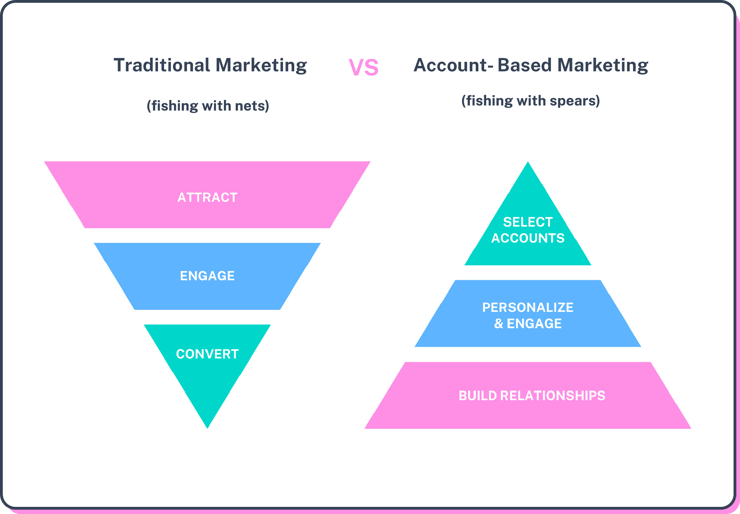
For SaaS companies, ABM offers a more holistic view of marketing, beyond the usual lead generation approach. Marketing to existing customer accounts to encourage upselling and cross-selling is one of the keys to getting the most value from your largest accounts and offers many benefits over other marketing approaches:
Improved reputation and relationships
In the Saas industry, building trust with leads and customers through openly sharing updates and information leads to strong, trusting relationships. Companies that use ABM have reported an 84% improvement in reputation and 80% improvement in customer relationships, due to implementing such things like client service management, automated list generations, or customer notifications.
Clearer ROI
Bringing in quality leads is what makes ABM really stand out: 73% of marketers report an increase in average deal size specifically in ABM accounts—where the focus is shifted on quality of leads over quantity.
Shorter sales cycles
Consider this: Traditional marketing tends to start at a lower level in the organization and moves slowly towards the primary decision maker. In ABM, the length of the cycle is shortened as all prospects are nurtured simultaneously—including C-level executives, who ultimately make the decisions regarding major purchase decisions.
Switch your approach to ABM and you too could see greater than 100% engagement increase with your C-level targets.
Less wasted resources
Time and resources are narrowly focused on a small number of accounts that are most likely to close sales. While your sales team typically spends hours analyzing prospects, ABM helps reduce up to 50% of sales time wasted on unproductive prospecting.
SaaS Marketing Budgets Made Simple
Now that we’ve taken some time to discuss your industry, brand, and, most importantly, your customers, it’s time to talk about budgets! If you can use what you already know about the best SaaS marketing strategies, you’ll have all the tools you need to build a budget that suits your business down to the ground.
How much do SaaS companies spend on marketing?
The most successful SaaS companies spend around half their revenue on marketing, and for startups, this can be considerably more:
Redpoint venture capitalist Tomasz Tunguz, studied the marketing budgets of several leading SaaS companies and found an initial marketing allocation of 80-120% of revenue. Once established, the amount gradually decreased to around the 50% mark.
Given the competitive nature of the industry and the time it takes for a SaaS business to become well-known, this level of investment in marketing is understandable. Even though it is higher than the overall average, your SaaS company will not have the same outgoings as something like an ecommerce brand, for example. The fact that you create software means you are already saving money on materials, brick-and-mortar storage facilities, and supply chain management costs.
What kind of investment can you afford to make?
Having a thoughtfully allocated marketing budget is important, so be sure to answer the following questions about your company before forging ahead:
- What are your current liabilities and expenses?
- What is your intended growth for the next 12 months?
- How much are your customers costing you: What is your customer lifetime value?
- What is your annual recurring revenue?
- What are your marketing goals?
- Are you expecting to expand your software range or services?
- Who will carry out your digital marketing?
With all of these questions answered, you’ll have sight of the bigger picture and the kind of investment you can afford to make.
Which SaaS marketing benchmarks should you track?
Sometimes, it’s not enough to merely track the key performance indicators (KPIs) needed for your SaaS business. At some point, you have to know whether or not your current metrics are good enough. SaaS marketing benchmarks provide a logical way to compare yourself to industry averages, create realistic goals and improve your campaign’s performance.
Marketing campaign ROI
Campaign ROI is the ultimate measure of whether your marketing investments are successful. Because ROI is a more difficult metric to measure in larger SaaS companies, with more siloed departments, many marketing teams instead focus on their cost per lead.
Cost per lead
CPL is a general measure of how effective your marketing efforts are at lead generation. Unlike ROI, CPL doesn’t account for how much revenue those leads actually represent, making it a less accurate measure of success.
Organic traffic
Traffic that originates from unpaid searches is an excellent leading indicator of future leads when combined with your conversion rates. It is also a key part of sustainable lead generation, as paid channels result in lower average ROI.
Visitor to lead conversion rate
Your visitor to lead conversion speaks to the effectiveness of your website at capturing visitor attention and encouraging them to convert. In a SaaS context, these conversions often consist of demo downloads in addition to the standard contact form fill.
Lead to MQL conversion rate
A high lead to MQL conversion rate demonstrates that your marketing is reaching the right audience of prospective customers.
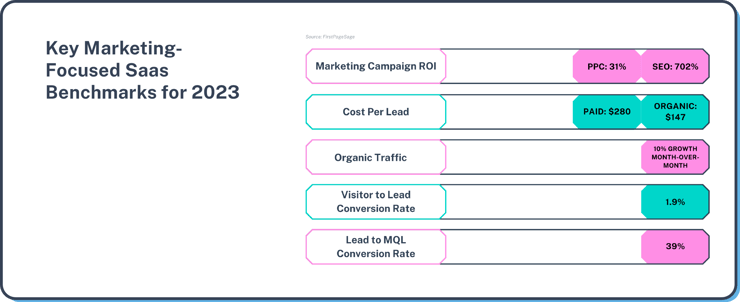
Conclusion
Where successful SaaS companies may differ in their portfolios, the one thing they all have in common is an excellent digital marketing strategy. In order to compete with the industry heavy hitters, you’ll need to effectively communicate how your software works, its uses, and why it stands out from the crowd. It’s not just about how much you budget, but how effectively you use that money.
At Prism Digital, we understand precisely how to use content marketing to position your brand as an authority. When you hire one of our marketing consultants, you get access to their hard-fought wisdom. From creating customer personas to keyword research and structuring content that targets every layer of the sales funnel, we can tell you what does or doesn’t work and deliver meaningful and actionable insights to get the best bang for your buck! After all, developing strategies for SaaS companies is one of our points of expertise.
.png?width=200&height=73&name=Logo(1).png)
